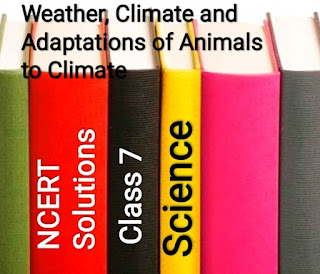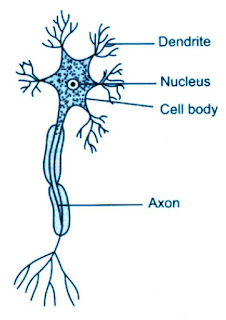NCERT Solutions for Class 7 Science Chapter 7 Weather, Climate and Adaptations of Animals to Climate
NCERT Solutions for Class 7 Science Chapter 7 Weather, Climate and Adaptations of Animals to Climate
-------------------------------------------------------------
Board CBSE
-------------------------------------------------------------
TextBook NCERT
-------------------------------------------------------
CLASS Class 7
--------------------------------------------------------
SUBJECT Science
----------------------------------------------------------
CHAPTER Chapter 7
-------------------------------------------------------------
SUBJECT Weather, Climate and Adaptations of Animals to Climate
--------------------------------------------------------------
You May Also Like NCERT Solutions Class 7
Chapter 12: Reproduction in Plants
Chapter 13: Motion and Time
Electric Current and Its Effects
Chapter 15: Light
Must Visit: 1. MCQ Class 7 Science.
3. NCERT solutions Class 7 Science
4. NCERT solutions Class 7 Maths
4. Question 1.
Name the elements that determine the weather of a place.
Answer:
The factors which determine the weather of a place are :
(i) temperature,
(ii) humidity,
(iii) rainfall, and
(iv) wind-speed.
Question 2.
When are the maximum and minimum temperatures likely to occur during the day?
Answer:
The maximum temperature of the day generally occurs in the afternoon (because in the afternoon sun rays directly fall over head) while the minimum temperature occurs generally in the early morning (because after the sun sets, the earth does not get heat of the sun any more but it continuously release heat in space till early in the morning. Hence early in morning earth's temperature becomes minimum).
Question 3:
Fill in the blanks:
(i) The average weather taken over a long time is called ___________.
(ii) A place receives very little rainfall and the temperature is high throughout the year, the climate of that place will be ___________ and ___________.
(iii) The two regions of the earth with extreme climatic conditions are ___________ and __________.
Answer 3:
(i) The average weather taken over a long time is called the climate of that place.
(ii) A place receives very little rainfall and the temperature is high throughout the year, the climate of that place will be hot and dry.
(iii) The two regions of the earth with extreme climatic conditions are tropical region and polar region.
Question 4.
Indicate the type of climate of the following areas:
(а) Jammu and Kashmir : ……….
(b) Kerala : ………
(c) Rajasthan : ………..
(d) North – east India : ………
Answer: 4
(a) Jammu and Kashmir : Moderately hot and moderately wet (very cold in winter).
(b) Kerala : Very hot and wet( because Kerala lies near coastal region)
(c) Rajasthan : Hot and dry ( maximum time of the year temperature is high) but only for a month or two, in winter the temperature is low. Very little rain falls occurred here.
(d) North – east India : Wet ( because major time of the year it receives rain)
Question 5:
Which of the two changes frequently, weather or climate?
Answer 5:
Weather changes frequently.
Question 6:
Following are some of the characteristics of animals:
Each characteristic indicates whether it is adaptation for tropical rainforests or Polar Regions. Do you think that some of these characteristics can be adapted for both regions?
Answer 6:
NCERT Solutions for Class 7 Science Chapter 7 Weather, Climate and Adaptations of Animals to Climate
Question 7.
The tropical rainforest has a large population of animals. Explain why it is so.
Answer:
The tropical regions are located near the equator. They have a hot and wet climate. The rainforests support a large variety of animals. This is because of the warm climate, constant supply of water and availability of a wide variety of food.
Question 8.
Explain, with examples, why we find animals of a certain kind living in particular climatic conditions.
Answer:
Animals are adapted to the conditions in which they live. These adaptations are just because of the long process of evolution. It would be difficult for them to survive if they are moved to regions having different climate conditions than from their habitat. Consider the following examples:
A polar bear has a thick layer of fat under their skin which acts as a heat insulator. It
protects the bear from the extreme cold climate of the polar region. The polar bear cannot survive if it is moved to a hot and dry desert region.
Monkeys have long tails for grasping branches adapted to live in tropical rain
forests. It cannot survive in Polar Regions.
Question 9:
How do elephants living in the tropical rainforest adapt to themselves?
Answer 9
The elephant is well adapted to living in rainforests.
(i) It has a strong sense of smell because it uses its long trunk as a nose.
(ii) It uses its trunk to pull down fruits and
leaves to eat.
(iii)It uses its tusks to tear the bark from
trees, which it eats.
(iv) It uses its long ears to hear even soft sounds, and also to cool itself in the hot and humid climate.
Choose the correct option which answers the following question:
Question 10.
A carnivore with stripes on its body moves very fast while catching its prey. It is likely to be found in
(i) polar regions
(ii) deserts
(iii) oceans
(iv) tropical rainforests
Answer:
(iv) tropical rainforests
Question 11.
Which features adapt polar bears to live in extremely cold climates?
(i) A white fur, fat below skin, keen sense of smell.
(ii) Thin skin, large eyes, a white fur.
(iii) A long tail, strong claws, white large paws.
(iv) White body, paws for swimming, gills for respiration.
Answer:
(i) A white fur, fat below skin, keen sense of smell.
Question 12.
Which option best describes a tropical region?
(i) Hot and humid
(ii) Moderate temperature, heavy rainfall
(iii) Cold and humid
(iv) Hot and dry
Answer:
(i) Hot and humid
NCERT Solutions for Class 7 Science Chapter 7 Weather, Climate and Adaptations of Animals to Climate


